Monday, November 28 | 11:20 a.m.-11:30 a.m. | SSC09-06 | Room S504CD
In this paper presentation, Dutch researchers will show early promising results for two novel molecular imaging techniques to detect and manage lymph node metastases in prostate cancer patients.Researchers from Radboud University Nijmegen are evaluating ferumoxtran-10-enhanced MRI (MR lymphography [MRL]) and carbon-11 (C-11) choline PET/CT to assess the number, size, and location of lymph node metastases.
"Molecular imaging techniques such as ferumoxtran-10-enhanced MRL and C-11 choline PET/CT have the ability to visualize specific cell or tissue function," explained presenter Dr. Ansje Fortuin. "MRL and PET/CT can detect lymph nodes suspected for metastasis, irrespective of existing size and shape, resulting in detecting metastases also in normal size lymph nodes, as well as finding suspicious lymph nodes outside the conventional clinical target volume."
The study included 29 patients with primary or recurrent disease who underwent MRL and PET/CT for lymph node evaluation. Researchers took note of the number, size, and location of lymph node metastasis, with locations described as within or outside the standard clinical target volume for elective pelvic irradiation.
With MRL, 738 nodes were visible, with 151 lymph nodes deemed positive in 23 of 29 patients. PET/CT detected only 132 lymph nodes, with 34 positive lymph nodes in 13 out of 29 patients.
The mean diameter of detected suspicious lymph nodes on MRL was significantly smaller (4.9 mm) than for those found on PET/CT (8.4 mm). In 14 of 29 patients, suspicious lymph nodes were found outside the clinical target volume with MRL, compared with only four of 29 patients with PET/CT.
MRL and C-11 choline PET/CT could improve the detection of lymph node metastases in prostate cancer inside and outside the clinical target volume and could influence clinical management, Fortuin and colleagues concluded.
"These modalities may have a potential role in the workup of prostate cancer patients who may be candidates for whole pelvic radiation therapy, may allow [physicians] to individualize treatment selection, and may enable image-guided radiotherapy in patients with prostate cancer lymph node metastases," Fortuin said.




















